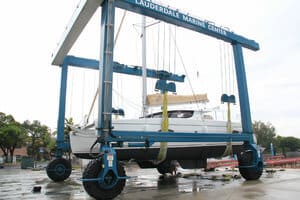 It is important to be as informed as possible when you go into a yacht purchase. Paying a professional surveyor to inspect the yacht and evaluate its condition is part of that process. However, before you set out to look at the boat in question, get as much information as you can about the boat from the owner or listing broker.
It is important to be as informed as possible when you go into a yacht purchase. Paying a professional surveyor to inspect the yacht and evaluate its condition is part of that process. However, before you set out to look at the boat in question, get as much information as you can about the boat from the owner or listing broker.
The cost of traveling to and from the these yachts as well as the cost for a haulout and survey can add up pretty quickly. It is very disappointing, after spending all the money for travel, surveyor, and haulout just to find out that it was a deal breaker right from the start. We put together a checklist of some questions to ask and things to do before you even think about traveling to see a particular yacht. Once you are satisfied that you have the answers to your questions and are still interested, take a peek at the yacht armed with our Pre-Survey Checklist. Below, we put together an initial inspection checklist to help you do a quick inspection of the boat to determine if it is worth a further look. This checklist is not designed to replace a proper survey, but it will give you a good idea of the general condition of the boat and whether you wish to continue looking into buying the boat. Make lots of notes and take pictures to use for later for analysis and comparison.
Things To Do BEFORE You Look At The Yacht
- First take a look at the pictures and layout of the yacht. Determine if this layout will work for your application, e.g., “owner’s cabin / suite” vss “charter” layout (maximimum cabins).
- Go over the specifications and inventory lists. Make sure that the yacht has the equipment that you want on board or can easily be fitted. If not, ask your broker for advice and estimates to add air conditioning, washer, dryer, etc.
- Check the age of equipment like sails, watermaker, etc. to determine when or if it needs replacing.
- Get engine and generator hours.
- Find out the history of the yacht: Charter boat / cruising boat / day sailor / fresh water sailor or ocean/salt water
- Find out location of the yacht. This can tell you a lot about how much use the boat had, for example, Canada has a much shorter sailing season and is therefore charter yachts from there are less used.
- Acquire service records for the yacht.
- Ask your broker for the number of similar yachts for sale as it greatly influences the price of a yacht.
- Ask your broker for price comparisons of the same or similar yachts sold in the last 6 months to 1 year.
- Find out about common problems with similar boats or models, e.g., de-lamination was a big problem on the old Wildcats. If you know of common defects on the boat of your choice, make that a major focus of your research and inspection.
- Seller should provide the H.I.N. number of the yacht. This number can tell you who the builder is, where it was built, and the year it was built.
Pre-Survey Boat Inspection Checklist
Use this checklist to help you vet a boat you are interested in before you invest in an on-deck visit or professional marine survey.
|
Boat Inspection Checklist Exterior:
Deck:
Engine:
Rigging & Sails:
Interior:
|





